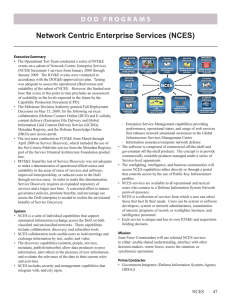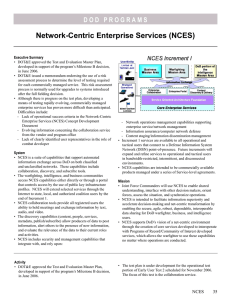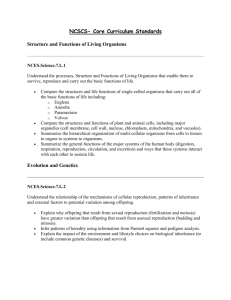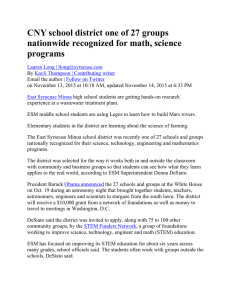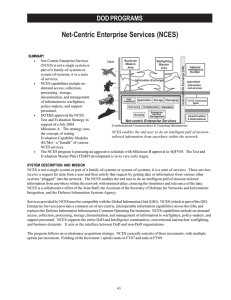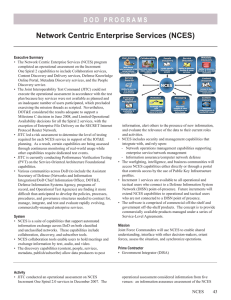d o d P r o g r...
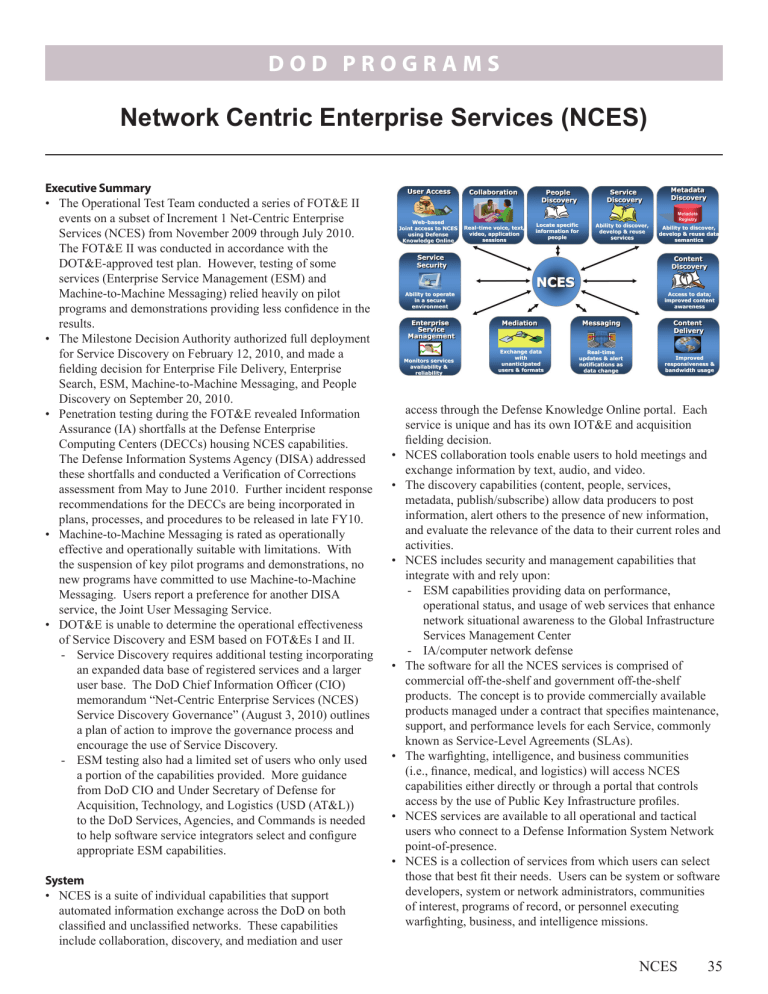
d o d P r o g r a m s
Network Centric Enterprise Services (NCES)
executive summary
• The Operational Test Team conducted a series of FOT&E II events on a subset of Increment 1 Net-Centric Enterprise
Services (NCES) from November 2009 through July 2010.
The FOT&E II was conducted in accordance with the
DOT&E-approved test plan. However, testing of some services (Enterprise Service Management (ESM) and
Machine-to-Machine Messaging) relied heavily on pilot programs and demonstrations providing less confidence in the results.
• The Milestone Decision Authority authorized full deployment for Service Discovery on February 12, 2010, and made a fielding decision for Enterprise File Delivery, Enterprise
Search, ESM, Machine-to-Machine Messaging, and People
Discovery on September 20, 2010.
• Penetration testing during the FOT&E revealed Information
Assurance (IA) shortfalls at the Defense Enterprise
Computing Centers (DECCs) housing NCES capabilities.
The Defense Information Systems Agency (DISA) addressed these shortfalls and conducted a Verification of Corrections assessment from May to June 2010. Further incident response recommendations for the DECCs are being incorporated in plans, processes, and procedures to be released in late FY10.
• Machine-to-Machine Messaging is rated as operationally effective and operationally suitable with limitations. With the suspension of key pilot programs and demonstrations, no new programs have committed to use Machine-to-Machine
Messaging. Users report a preference for another DISA service, the Joint User Messaging Service.
• DOT&E is unable to determine the operational effectiveness of Service Discovery and ESM based on FOT&Es I and II.
- Service Discovery requires additional testing incorporating an expanded data base of registered services and a larger user base. The DoD Chief Information Officer (CIO) memorandum “Net-Centric Enterprise Services (NCES)
Service Discovery Governance” (August 3, 2010) outlines a plan of action to improve the governance process and encourage the use of Service Discovery.
- ESM testing also had a limited set of users who only used a portion of the capabilities provided. More guidance from DoD CIO and Under Secretary of Defense for
Acquisition, Technology, and Logistics (USD (AT&L)) to the DoD Services, Agencies, and Commands is needed to help software service integrators select and configure appropriate ESM capabilities.
system
• NCES is a suite of individual capabilities that support automated information exchange across the DoD on both classified and unclassified networks. These capabilities include collaboration, discovery, and mediation and user access through the Defense Knowledge Online portal. Each service is unique and has its own IOT&E and acquisition fielding decision.
• NCES collaboration tools enable users to hold meetings and exchange information by text, audio, and video.
• The discovery capabilities (content, people, services, metadata, publish/subscribe) allow data producers to post information, alert others to the presence of new information, and evaluate the relevance of the data to their current roles and activities.
• NCES includes security and management capabilities that integrate with and rely upon:
- ESM capabilities providing data on performance, operational status, and usage of web services that enhance network situational awareness to the Global Infrastructure
Services Management Center
- IA/computer network defense
• The software for all the NCES services is comprised of commercial off-the-shelf and government off-the-shelf products. The concept is to provide commercially available products managed under a contract that specifies maintenance, support, and performance levels for each Service, commonly known as Service-Level Agreements (SLAs).
• The warfighting, intelligence, and business communities
(i.e., finance, medical, and logistics) will access NCES capabilities either directly or through a portal that controls access by the use of Public Key Infrastructure profiles.
• NCES services are available to all operational and tactical users who connect to a Defense Information System Network point-of-presence.
• NCES is a collection of services from which users can select those that best fit their needs. Users can be system or software developers, system or network administrators, communities of interest, programs of record, or personnel executing warfighting, business, and intelligence missions.
NCES 35
d o d P r o g r a m s mission
Joint Force Commanders will use selected NCES services to enable shared understanding, interface with other decision-makers, orient forces, assess the situation, and/or synchronize operations.
major contractor
Government Integrator – DISA activity
• The Joint Interoperability Test Command (JITC) led a multi-Service operational test team that conducted a series of
FOT&E II events on a subset of NCES Increment 1 services from November 2009 through July 2010. The FOT&E II was conducted in accordance with the DOT&E-approved Test and
Evaluation Master Plan and operational test plan. However, testing of some services (ESM and Machine-to-Machine
Messaging) relied heavily on pilot programs and demonstrations providing less confidence in the results.
Services tested include the following:
- Enterprise File Delivery
- Enterprise Search
- ESM
- Machine-to-Machine Messaging
- People Discovery
- Service Discovery
• The Milestone Decision Authority authorized full deployment for Service Discovery on February 12, 2010, and made a fielding decision for Enterprise File Delivery, Enterprise
Search, ESM, Machine-to-Machine Messaging, and People
Discovery on September 20, 2010.
• The test team conducted an IA assessment for a subset of the
NCES services hosted at the DECCs. These assessments included IA documentation reviews, interviews with program office and hosting site personnel, penetration testing, and special events to assess restoration, failover, and incident response.
• The test team plans to conduct a continuous evaluation of the
ESM service to assess how it performs as the number of users increase. assessment
• The FOT&E II events were adequate to assess the operational effectiveness and suitability of a subset of NCES. Immature procedures and processes and the absence of sufficient numbers of end users limited the ability of DOT&E to assess
ESM and Service Discovery as operationally effective.
During the FOT&E II events, testers encountered significant limitations. An extremely limited user base for many services precluded an assessment of scalability to the levels envisioned in the Capabilities Production Document for the DoD enterprise. In addition, inconsistent quality of data provided by the various Managed Service Providers precluded an assessment of suitability.
• The following is a synopsis of the results for each service evaluated during the FOT&E events:
- The Enterprise File Delivery Service successfully synchronizes content to multiple consumers on the unclassified network and is operationally effective. It is considered operationally suitable with limitations. The
SLA and documentation need improvement.
- Enterprise Search is assessed as operationally effective with limitations. Improvements were made in timeliness, relevance of results, methods for exposing information, and the number of content sources since the IOT&E in 2008. However, users did not find that the NCES
Enterprise Search provided advantages over existing search tools. Enterprise Search is also assessed as operationally suitable with limitations. User documentation and support to content owners need improvement.
- DOT&E was unable to determine the operational effectiveness of ESM due to the low level of use (only one of three monitoring agents was used during the test) and because a majority of services being monitored were not being used in an operational context. Users report
ESM provides a needed capability to optimize software performance and provide them situational awareness for distributed software services. More guidance from
DoD CIO and USD (AT&L) is needed to enable software service integrators to select and configure appropriate ESM capabilities. Also, further testing should be conducted in which ESM provides situational awareness and management of operational services. ESM is considered to be operationally suitable due to its ease of use and good help desk support.
- Machine-to-Machine Messaging is rated as operationally effective and operationally suitable with limitations. Users reported the service performs the required functions, but the users had problems troubleshooting faults, configuring security devices, and monitoring service health and status, and were not notified of upgrades or outages. With the suspension of key pilot programs and demonstrations, no new programs have committed to use Machine-to-Machine
Messaging. Users report a preference for another DISA service, the Joint User Messaging Service. Since the
DOT&E report, Machine-to-Machine Messaging has been integrated with a new Program of Record and the Program
Office is currently working with several potential users.
36 NCES
d o d P r o g r a m s
- Upgrades to People Discovery demonstrated marked improvement and it is now considered operationally effective with limitations and operationally suitable.
There is improved consistency of results and access to more authoritative personnel sources. The service meets availability and performance requirements and is easy to use. Users would like to see more contact information listed for each person, especially for People Discovery search results on the classified network. There is a need for the various authoritative personnel databases to maintain a consistent amount and type of personnel information/ attributes on individuals to ensure accurate People
Discovery search results (e.g. phone numbers, e-mail addresses, work organization).
- An upgrade to Service Discovery resolved findings from the FOT&E I, including user interface and documentation shortcomings. The DoD CIO signed a memorandum
(NCES Service Discovery Governance) on August 3, 2010, with a Plan of Action to improve the governance processes and encourage the use of Service Discovery and the reuse of registered services. However, there is still a lack of sufficient governance processes for practical implementation of Service Discovery and Enterprise adoption to assess the mission benefits of service re-use.
• FOT&E II survivability assessments identified significant
IA deficiencies at the sites hosting NCES capabilities. As a result of the FOT&E II assessment, DISA made adjustments to hosting sites and security practices. JITC conducted a
Verification of Corrections assessment of these IA deficiencies from May to June 2010. Further incident response recommendations are being incorporated in plans, processes, and procedures to be released by DISA in late FY10.
recommendations
• Status of Previous Recommendations. The DoD CIO, DISA, and JITC satisfactorily addressed two of the three FY09 recommendations. The recommendation concerning periodic independent assessments to evaluate scalability of services to
Enterprise levels remains.
• FY10 Recommendation.
1. DISA and the NCES Program Management Office should conduct assessments evaluating adoption across the DoD and the utility of the Machine-to-Machine Messaging and
People Discovery.
NCES 37
38 d o d P r o g r a m s
